Mary Dunhill
May Dunhill was the last child and only daughter of Alfred Dunhill [1872-1959], the founder of Alfred Dunhill a company that moved from selling motoring accessories to tobacco products before becoming the luxury brand it is today.
Mary joined the family business in 1924 as an assistant cashier and then moved through other areas of the firm before leaving in 1926 to establish Mary Dunhill Salons Ltd. and open a salon at 39 Craven Road, Lancaster Gate, London.
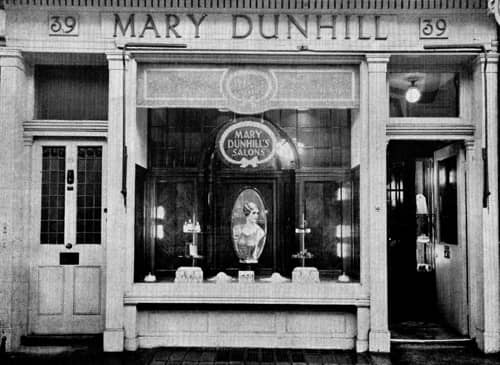
Above: Mary Dunhill salon at 39 Craven Road Lancaster Gate, London. It offered hairdressing services and sold cosmetics.
Exactly why she started out on her own is not clear. Balfour writes that it was her uncle, Herbert Dunhill [1884-1950], who first suggested the idea but Mary states that the impetus came from her father (Dunhill, 1979, pp. 77-78). Both may be right. Herbert Dunhill may have made the initial suggestion but Alfred Dunhill appears to have bankrolled the business. He owned most of the shares in the new company and gave them to Mary in 1927 when the business was seen to prosper (Balfour, 1992, pp. 86-87). Mary writes that her father had bankrolled the business was so that she could sell hair oil and face creams from an Edgware business he had recently bought an interest in (Dunhill, 1979, p. 77).
In February, 1931, Mary Dunhill expanded into the second and third floors of Craven Road before moving down the road to 34a in 1936. However, after a promising start, the business fell into difficulties and ceased trading in 1940. The tipping factor for the closure was probably the outbreak of the Second World War in September, 1939.
The close of Mary Dunhill did not mean the end of Mary’s business career. In 1943, she became a director of Alfred Dunhill Ltd. and then went on to become the chairman of the company in 1961 and company president in 1975. It was also not the end of Mary Dunhill cosmetics as an American branch of Mary Dunhill had been established in 1934.
David A. Schulte
The establishment on Mary Dunhill, Inc. in New York in 1934 appears to have been instigated by David A. Schulte, an American businessman who controlled a chain of tobacco stores started by his brother-in-law Anthony Schulte.
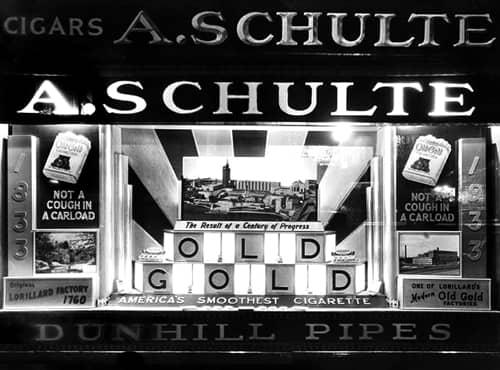
Above: 1933 A Schulte tobacconist store in the United States advertising Dunhill pipes.
It was Schulte’s tobacco interests had brought him into contact with Alfred Dunhill and then Mary Dunhill. In 1920, Schulte had persuaded Alfred Dunhill and his younger brother Herbert Dunhill to expand the Alfred Dunhill business. In 1921, Alfred Dunhill of London, Inc. was formed in New York, followed by Alfred Dunhill of London Ltd. in Toronto, Canada in 1922 and Société Anonyme Française Alfred Dunhill (SAFAD) in France in 1924.
Mary Dunhill had close ties with David A. Shulte, whom she refers to as DA in her book. In 1927, she had travelled to New York at his invitation and appears to have got on very well with the Schulte family and with Shulte’s son Arthur in particular.
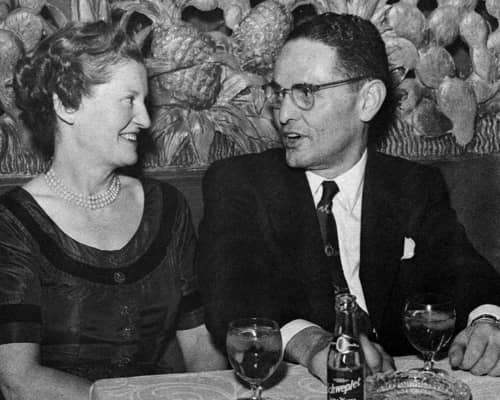
Above: Mary Dunhill and Arthur David Schulte [1906-1995].
D. A. Schulte was no stranger to cosmetics. In 1924, another company he controlled, Schulte Retail Stores, had bought V. Vivaudou, the cosmetics company established by Victor Vivaudou [1881-1954] in 1914, best known for its Mavis range. Exactly why D. A. Schulte decided to start up the Mary Dunhill line in the United States is unknown but he may have seen it as a good accompaniment to the Dunhill company’s growing range of luxury goods.
Luxury goods
When the previously mentioned Société Anonyme Française Alfred Dunhill (SAFAD) was established in France it opened a Dunhill shop at 15 Rue de la Paix, Paris.
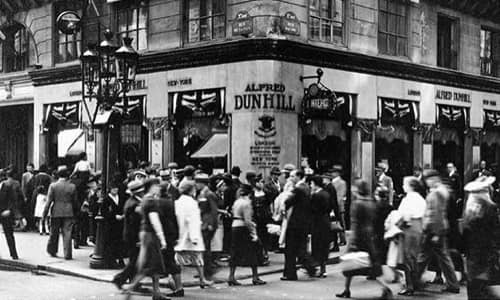
Above: 1937 Alfred Dunhill shop at 15 Rue de la Paix, Paris. The company still operates there today.
The French government held a monopoly on the sale of tobacco so the only tobacco-related goods the Dunhill shop in Paris could stock were smoking accessories like pipes and cigarette lighters. SAFAD obtained an import licence for some Alfred Dunhill tobacco blends in 1925 but these could only be purchased through mail-order.
The general manager of the Paris store, Clement F. Court, had previously managed the Paris branch of Mappin & Webb (silversmiths and jewellers) and in place of the tobacco products he introduced a range of luxury goods into the Rue de la Paix shop. Many of these were aimed at women.
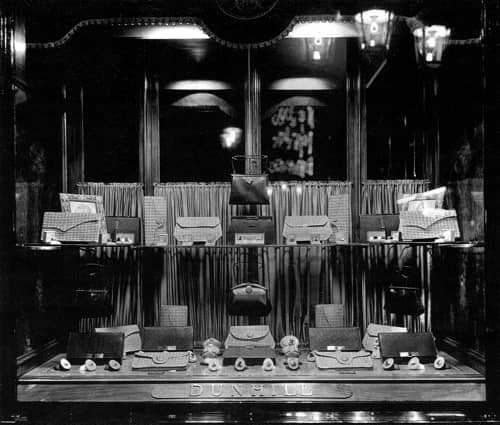
Above: Window from the Alfred Dunhill shop in Paris showing a range of women’s accessories including handbags.
Included in these luxury goods were vanities to hold powder, rouge and lipstick. Dunhill did not make cosmetics so these had to be filled with make-up from other companies.
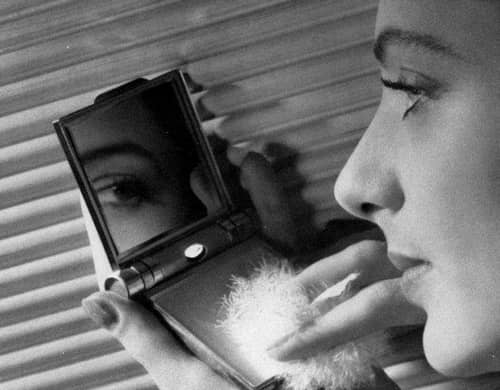
Above: 1936 Alfred Dunhill compact sold at the Dunhill store at 15 Rue de la Paix, Paris.
Similar luxury items were soon being sold in the Dunhill store in New York and then later in London. This opened the possibility of Mary Dunhill cosmetics and accessories being retailed there as well. As they carried the name Dunhill, D. A. Schulte probably reasoned they would benefit from Dunhill’s growing reputation as a luxury brand.
Balfour writes that Mary Dunhill cosmetics – four fragrance lines, lipsticks and powder compacts – first went on sale in the United States in 1930 (Balfour, 1992, p. 112). If this was the case they would have been sold through the Dunhill store at 512-514 Fifth Avenue and then later in the new Dunhill shop in British Empire Building at the Rockefeller Centre on 5th Avenue when Dunhill moved there in 1933. Unfortunately, I have no corroborating evidence that this was the case.
In 1934, Mary Dunhill, Inc. was established as a subsidiary of Dunhill International Inc., a company founded by Schulte in 1923 which also had Alfred Dunhill of London, Inc. (New York) as a subsidiary. There were a number of connections between these firms: Mary Dunhill was headquartered at 11 East 26th Street, New York, the same address as Alfred Dunhill of London which had moved there in 1926; Mary Dunhill’s first president was Arnold L. Ogden who had become president of Alfred Dunhill of London in 1933; and Mary Dunhill’s first advertising agency was the H. Sumner Sternberg Company, a New York form that also held the advertising account for Alfred Dunhill of London.
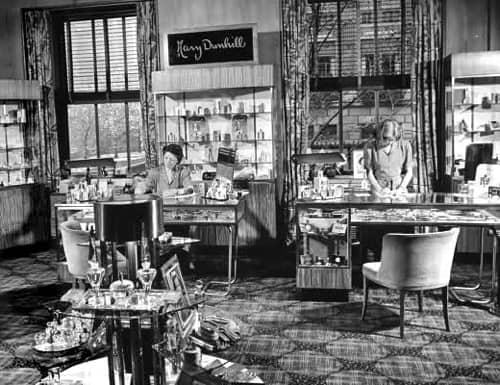
Above: Mary Dunhill shop in New York. One window appears to be overlooking Madison Square Park which suggests this was photographed at 11 East 26th Street.
Products
I have not been able to find any trace of Mary Dunhill products sold in Britain at any stage or products sold in the United States before 1934 and there is only limited information on lines sold in America after 1934. These were produced in the United States under licence which suggests that they were manufactured in America rather than imported from Britain which means they would not have been affected by the closure of Mary Dunhill Ltd. in 1940.
The cosmetics range was not extensive and the company’s strengths were in perfumes, compacts and other cosmetic accessories.
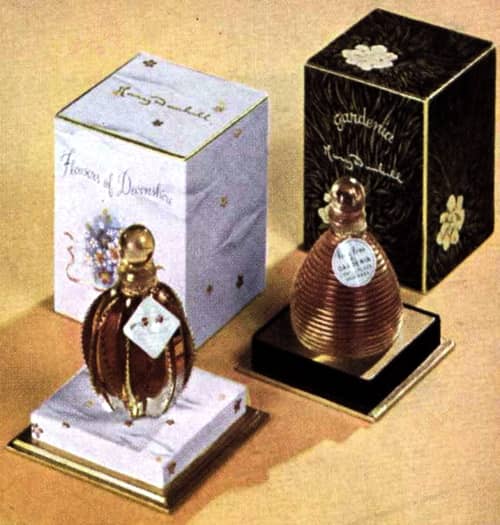
Above: 1950 Mary Dunhill Flowers of Devonshire and Gardenia perfumes. Other perfumes released by Mary Dunhill included Amulet (1938), Bewitching (1941), White Hyacinth (1941), Amulet (1938), and Escape (1943).
Some Mary Dunhill colognes and lipsticks could be ‘personalized’ with the initials of the owner added when it was purchased. The idea used a patent granted to Arthur Mainzer (US: 2231364, 1940) assigned tp Mary Dunhill.
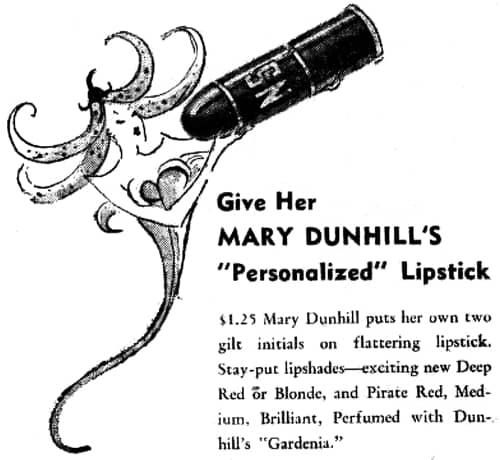
Above: 1941 Mary Dunhill Personalized Lipstick.
Skin-care
The Mary Dunhill skin-care cosmetics introduced in 1934 consisted of Devonshire Cleansing Cream, Mary Dunhill Nourishing Cream, Mary Dunhill Devonshire Astringent, Mary Dunhill Skin Tonic and Mary Dunhill Hand Cream with the Devonshire Cleansing Cream featuring heavily in early advertising. The Mary Dunhill skin-care routine seems to have been a standard cleanse, tone and feed the skin regime with few allowances made for skin types.
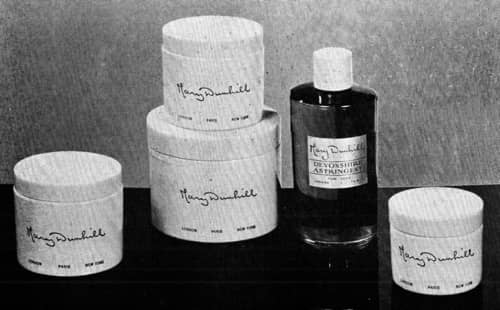
Above: 1934 Mary Dunhill skin-care cosmetics sold in pale, peach-pink containers with matching screw-capped lids with Mary Dunhill’s signature displayed prominently on the side of the jars.
Other known lines are Mary Dunhill Complexion Stimulant, Mary Dunhill Devonshire Complexion Tonic, Mary Dunhill Devonshire Skin Tonic, Mary Dunhill Devonshire Liquid Hand Cream and Mary Dunhill Eventan Cream.
Devonshire Cleansing Cream: “A special formula cream that cleanses more thoroughly and more easily than you ever dreamed possible.”
Devonshire Skin Lotion: “A refreshing pick-up for both dry and normal skin.”
Devonshire Texture Cream: “Deliciously soothing. Its emollient quality softens as it smooths. Excellent for dry skin.”
Devonshire Liquid Hand Cream: “[G]oes on like melted velvet, disappears fast, leaves your hands gentle.”
Eventan Cream: “[G]ives smart Tan without blistering or burning.”
The Mary Dunhill Nourishing Cream conflicted with the provisions of the 1938 Food Drugs & Cosmetic Act (FD&CA) and, in 1939, the company agreed to stop using the word ‘nourishing’ and replaced this product with Mary Dunhill Texture Cream. In 1939, Mary Dunhill was also forced to stop using the word ‘Paris’ on its product labels as it implied they had a Paris office which was not the case.
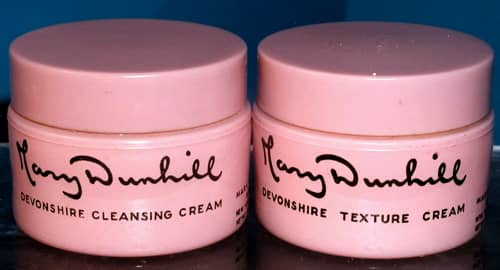
Above: Mary Dunhill Devonshire Cleansing Cream and Devonshire Texture Cream. In the 1940s, a number of the earlier skin-care creams had the word Devonshire added to their label.
Make-up
Information on Mary Dunhill make-up sold in the United States is also limited. As far as I can tell the range was restricted to foundations, cream and dry rouges, lipsticks and face powders. There are no suggestions the company ventured into eye make-up or sold nail polishes.
Powder and foundation
The company’s first foundation introduced into the United States was Mary Dunhill Finishing Cream which I imagine was a standard vanishing cream which acted as a base for Frou Frou de Gardenia Face Powder.
Gardenia face Powder: “[S]uperior, light-weight, adheres to the skin, delicately scented.”
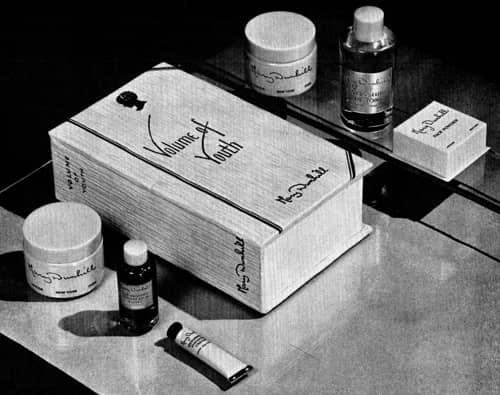
Above: 1935 Mary Dunhill Volume of Youth containing a tube of Mary Dunhill Finishing Cream and Mary Dunhill Face Powder which came in four shades.
The company also made a wide range of compacts and sold them in various combinations with Mary Dunhill lipsticks and perfumes.
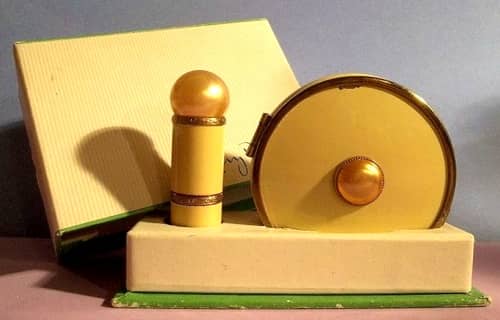
Above: Mary Dunhill Perl Top Lipstick and Compact.
In 1944, the company added Face It, a pigmented foundation that could also be worn without powder.
Face It: “[A] two-way mist make-up will carry you through any emergency with a smooth, well-groomed appearance. It clings to your face through thick and thin, worn without powder, it gives you a look of energetic good health.” Shades: Luscious, Daytime Blush, Evening Blush and Brunette.
The Pink Lustre shade was added in 1944 followed by other lustre shades – Rose Rachel Lustre, Brunette Lustre and Evening Lustre – added by 1946.
Lipsticks and rouge
Mary Dunhill Gardenia Lipsticks were creamy indelibles produced in four shades. They were sold in three different cases each with a different top: Frou Frou, Perl, and Rhinestone. The company also made cream and compressed powder (dry) rouge.
Frou Frou du Gardenia Lipstick: “Suave as to texture . . . frivolous as to container . . . impish as to intention. Permanent, smooth, indelible. Shades: Dark, Medium, Light, and Brilliant.”
Other lipstick shades included: Carnelian (1939); Pirate Red; Deep Red and Blonde (1941); Luscious, Thrilling, and Banner Red (1943); Furlough Red, Pink Lustre, and Black Lustre (1944); Cherry Lustre, Medium Lustre, Ruby Lustre, Sapphire Rose Lustre, and Copper Lustre (1945).
Colour coordination
Given the limited shade range and the lack of nail polish early colour coordination was limited to rouge and lipstick. After the introduction of Face It this was then occasionally extended to foundation and face powder. For example, the Pink Lustre shade (1944) came in Lipstick, Dry Rouge, Face It and Face Powder.
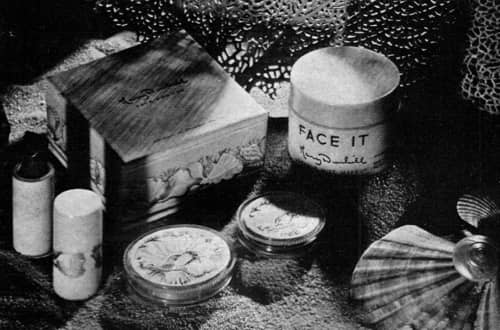
Above: 1944 Pink Lustre Lipstick Face Powder, Rouge and Face It.
Later developments
D. A. Schulte died in 1949 and Dunhill International was sold by Schulte’s sons to a group of investors who cheapened the Dunhill brand in the United States as the parent company moved further and further away from its original business. By 1967 – the year that it sold the assets of Alfred Dunhill of London Inc. to Alfred Dunhill Ltd. – Dunhill International was manufacturing such things as automobile parts, products for children and infants, and sporting goods.
Mary Dunhill, Inc. was still a subsidiary of Dunhill International in 1959 but had disappeared by the time Dunhill International had completed its merger with The Pyramid Rubber Company in February, 1962. By then, Dunhill International had over 517,000 shares in Coty, Inc. and the board may have viewed Mary Dunhill as conflicting with these interests or simply too small to bother with.
In Britain, Mary Dunhill, Ltd. had been purchased by Alfred Dunhill Ltd. in 1944, with Mary receiving £17,000 for the distribution agreements she had contracted with Mary Dunhill, Inc. in New York (Balfour, 1992, p. 88). Although the company had ceased trading it was not disbanded and was later resurrected under different name.
Dunhill Toiletries
Alfred Dunhill of London, Inc. (New York) had started a men’s range in 1944 and this had led to Dunhill International founding Alfred Dunhill Men’s Toiletries Ltd. in New York in 1946. In 1963, Alfred Dunhill Ltd. in London also established a men’s toiletries company but rather than registering a new firm they simply renamed Mary Dunhill Ltd. as Dunhill Toiletries Ltd. The renamed company then became responsible for the range of Dunhill men’s toiletries and accessories that are still on sale today.
Timeline
| 1926 | Mary Dunhill Salons Ltd. established at 39 Craven Road, Lancaster Gate. Changed to Mary Dunhill Ltd. Salon opened. |
| 1930 | Mary Dunhill products go on sale in the United States. |
| 1931 | London business expands into the 2nd and 3rd floors at Craven Road. |
| 1934 | Mary Dunhill, Inc. established at 11 East 26th Street, New York. |
| 1936 | London salon of Mary Dunhill moved to 34a Craven Road. |
| 1939 | New Products: Texture Cream. |
| 1940 | Mary Dunhill Ltd. ceases trading. |
| 1944 | Mary Dunhill Ltd. sold to Alfred Dunhill Ltd. Packaging updated. New Products: Face It. |
| 1945 | New Products: Lustre Lipsticks. |
| 1946 | Alfred Dunhill Men’s Toiletries Ltd. founded in New York by Dunhill International. |
| n.d. | Mary Dunhill, Inc. ceases trading in the United States. |
| 1963 | Mary Dunhill Ltd. becomes Dunhill Toiletries Ltd. |
| 1967 | Assets of Alfred Dunhill of London, Inc. (New York) bought by Alfred Dunhill Ltd. (London). |
19th September 2018
Sources
Balfour, M. (1992). Alfred Dunhill: One hundred years and more. London: Weidenfeld and Nicolson.
Dunhill, M. (1979). Our family business. London: The Bodley Head.
The national cyclopaedia of American biography. (1954). (Vol. 39). New York: James T. White & Company.
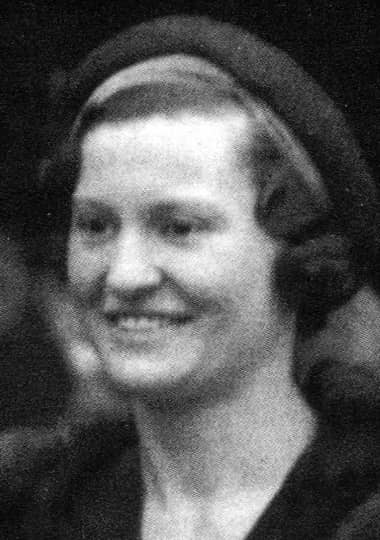
Mary Dunhill [1907-1988].
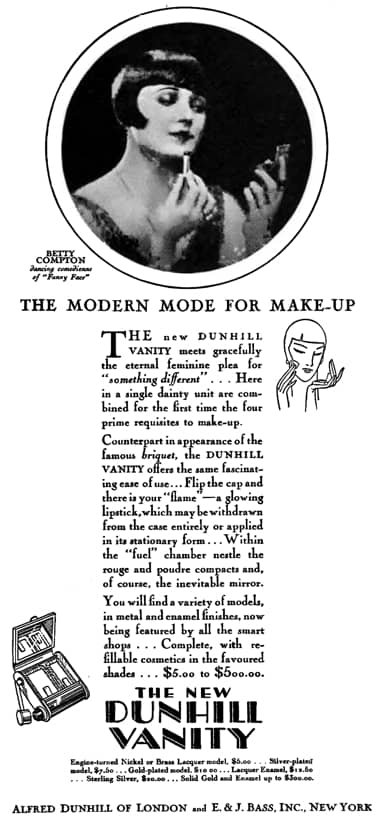
1928 Vanity from Alfred Dunhill of London (New York).
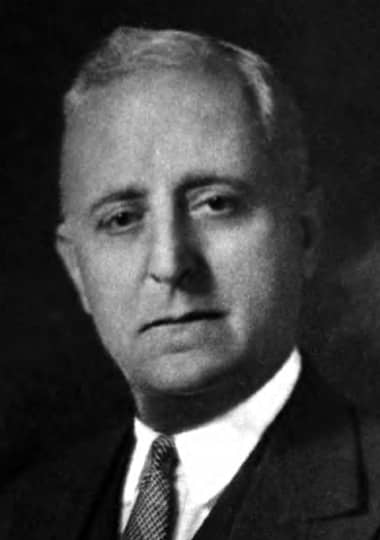
David A. Schulte [1873-1949]. Born David Goldberg he adopted the name Schulte after he went to work for his brother-in-law Anthony Schulte [1857-1903] in 1892 (The national cyclopaedia of American biography, p. 46).
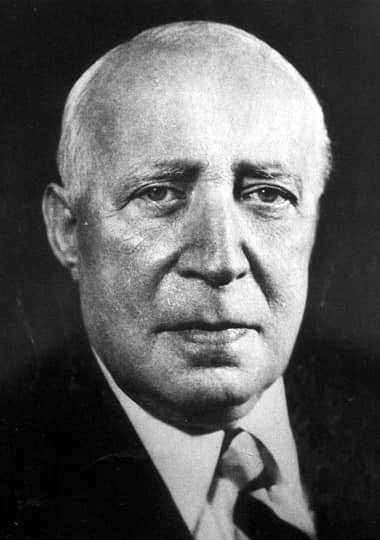
Arnold L. Ogden [1875-1953]. First president of Mary Dunhill, Inc. (New York) and designer of the case used for Frou-Frou lipsticks.
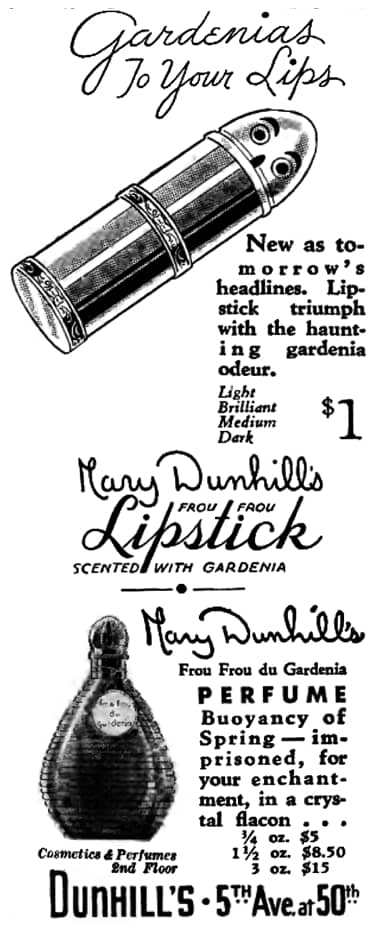
1935 Mary Dunhill Frou-Frou Lipstick.
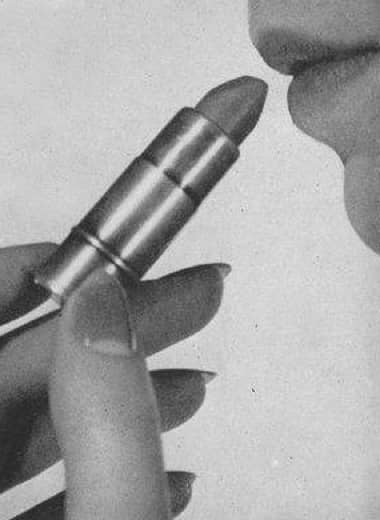
1939 Alfred Dunhill Masque a Gaz lipstick case sold in the Dunhill store at 15 Rue de la Paix, Paris. It was filled with a Guerlain lipstick.
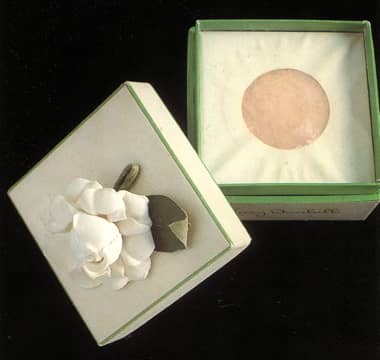
Mary Dunhill Gardenia Face Powder. When sold separately, the powder was attractively packed in a white silk box with green bindings that matched the leaves of the white gardenia attached to each box.
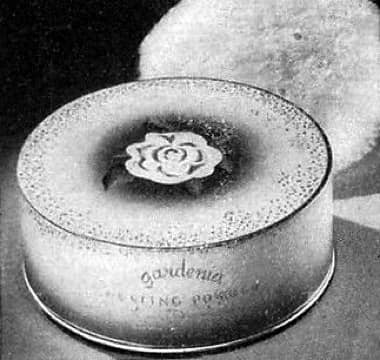
Mary Dunhill Gardenia Dusting Powder which also came in Hyacinth, Flowers of Devonshire and Bewitching scents.
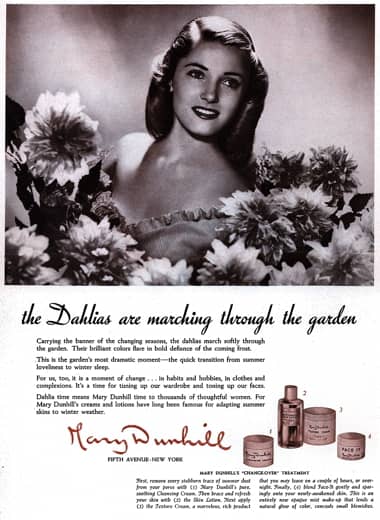
1943 Mary Dunhill Cleansing Cream, Devonshire Skin Lotion, Texture Cream and Face It.
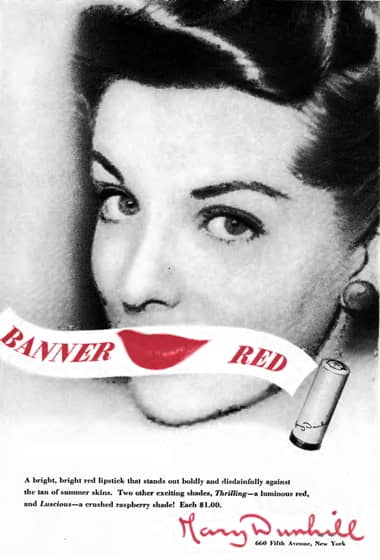
1943 Mary Dunhill Banner Red Lipstick.
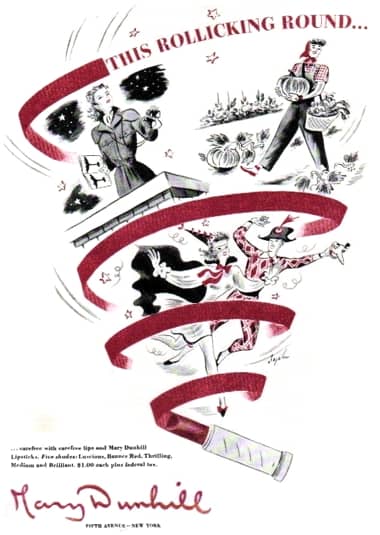
1943 Mary Dunhill Luscious, Banner Red, Thrilling, Medium and Brilliant Lipsticks.
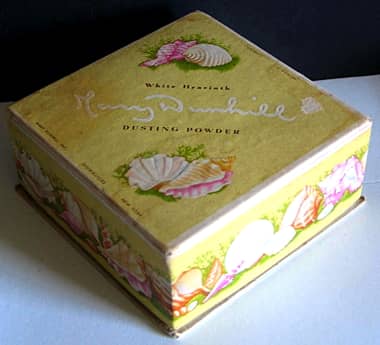
Mary Dunhill White Hyacinth Dusting Powder in the shell packaging introduced in 1944.
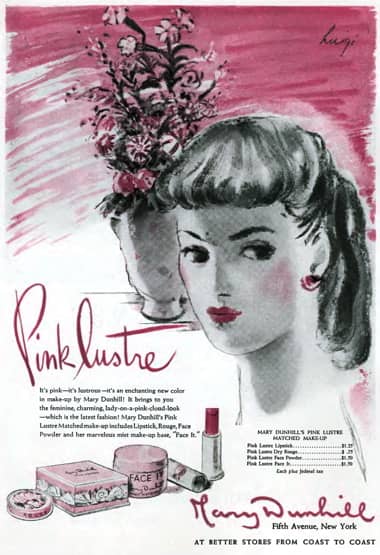
1944 Mary Dunhill Pink Lustre Dry Rouge, Face Powder, Face It, and Lipstick. some are in the new shell-patterned packaging.
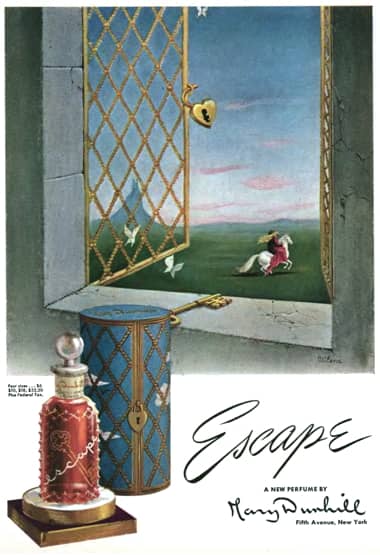
1944 Mary Dunhill Escape.
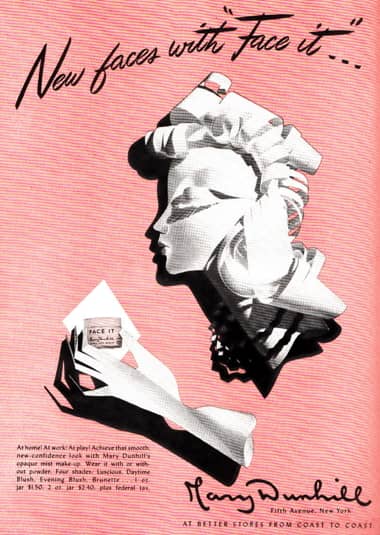
1944 Mary Dunhill Face It.
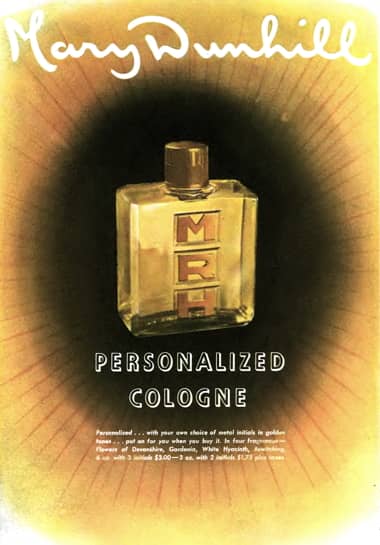
1945 Mary Dunhill Personalized Cologne.
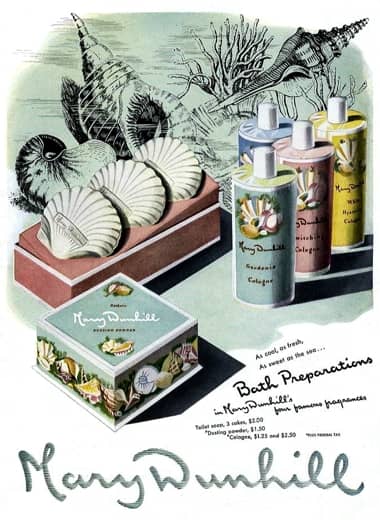
1945 Mary Dunhill Bath Preparations (Dusting Powder and Cologne) in new packs decorated with shell motifs introduced in 1944.
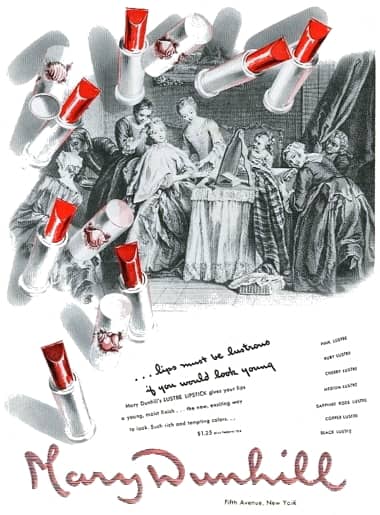
1945 Mary Dunhill Lustre Lipsticks in Pink Lustre, Ruby Lustre, Cherry Lustre, Medium Lustre, Sapphire Rose Lustre, Copper Lustre, and Black Lustre shades.
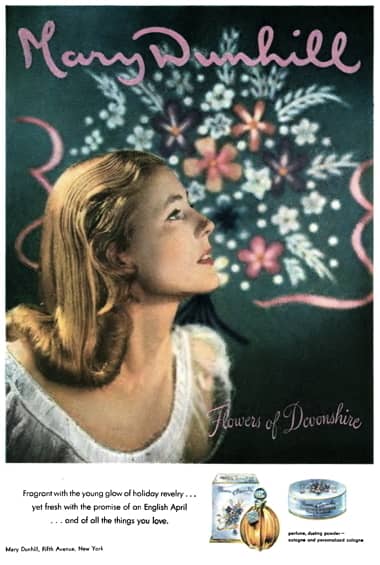
1946 Mary Dunhill Flowers of Devonshire Perfume and Dusting Powder.
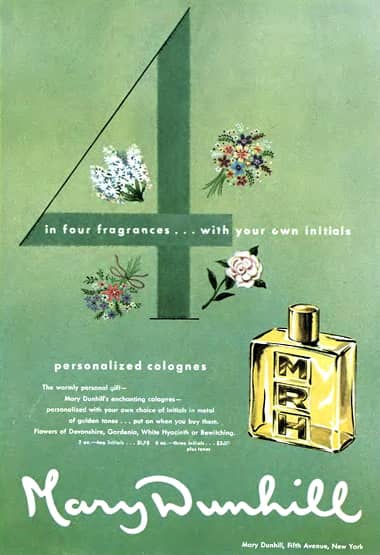
1946 Mary Dunhill Personalized Colognes.
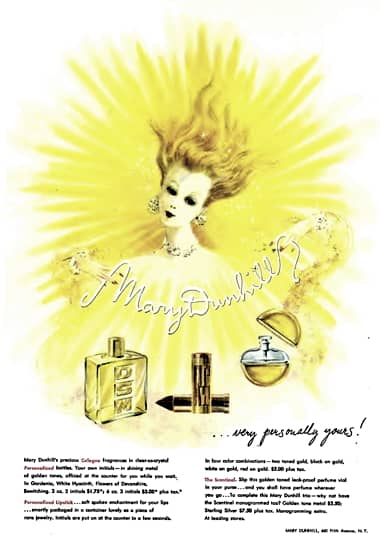
1947 Mary Dunhill Personalized Cologne, Personalized Lipstick and Scentinel perfume container.
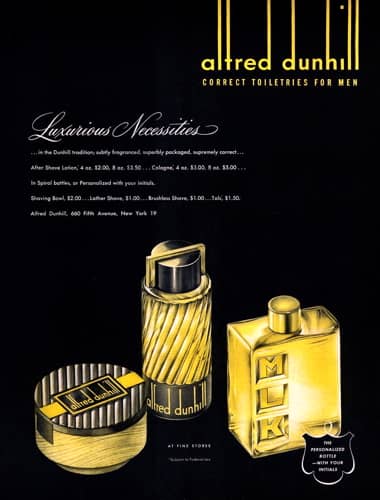
1947 Alfred Dunhill After Shave in spiral bottle or ‘personalized’ with the owner’s initials as sold by Alfred Dunhill Men’s Toiletries Ltd. (New York) the same idea used by Mary Dunhill.
